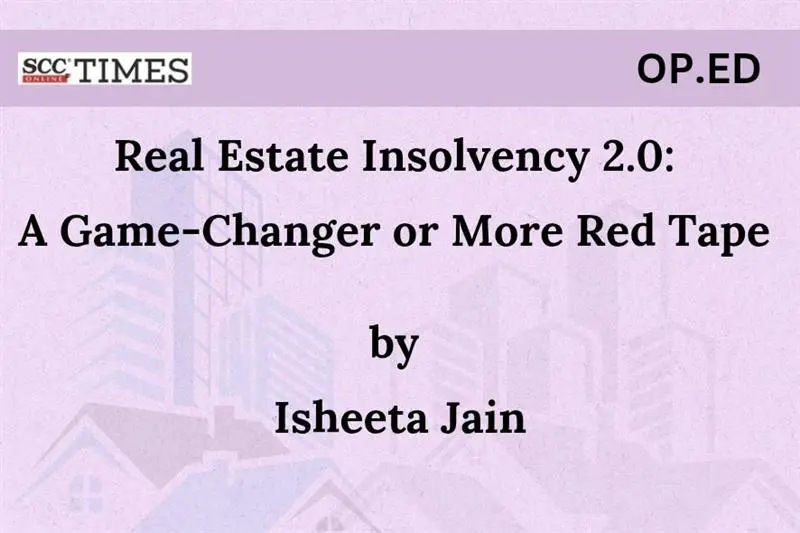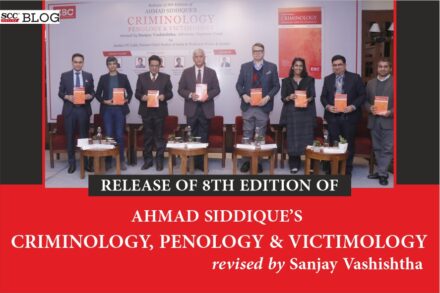Introduction: A new dawn for corporate insolvency?
The Insolvency and Bankruptcy Board of India (IBBI), through its Notification No. IBBI/2024-25/GN/REG1221 dated 3-2-2025, has unveiled a suite of amendments to the Insolvency and Bankruptcy Board of India (Insolvency Resolution Process for Corporate Persons) Regulations, 20162. Effective from 3-2-2025, these reforms aim to inject transparency, efficiency, and sector-specific clarity into insolvency proceedings, particularly in the real estate sector — a domain historically plagued by delays, unfinished projects, and distressed homebuyers. The latest overhaul enhances creditor protection, fosters structured participation, and brings regulatory oversight into sharper focus. But does this signal a bold stride towards insolvency resolution efficacy, or are we merely witnessing another regulatory labyrinth? Let us dissect the finer details.
Key amendments: The devil is in the details
Enhanced creditor protection: Homebuyers take centre stage
For the first time, homebuyers stand on stronger legal footing with explicit recognition and structured participation in the insolvency framework. The landmark ruling in Pioneer Urban Land and Infrastructure Ltd. v. Union of India3 and Chitra Sharma v. Union of India4 had already recognised homebuyers as financial creditors, but the latest amendments cement their position with concrete procedural entitlements. Regulation 4-E5 now mandates that the resolution professional (RP) must secure 66% of the Committee of Creditors (CoC) votes before handing over possession of real estate assets. This ensures that homebuyers, who have already fulfilled their contractual obligations, are not held hostage by protracted insolvency proceedings.
Homebuyers are likely to experience a faster and more predictable resolution process, rather than lingering in a state of legal limbo. Institutional lenders and financial creditors will gain greater confidence in funding real estate ventures, knowing that insolvency frameworks now better balance stakeholder interests.
Structuring the chaos: Facilitators to the rescue
With large creditor pools exceeding 1000 individuals, managing communication has been a logistical nightmare. The introduction of Regulation 16-C6 remedies this through the appointment of facilitators. A sub-class of at least 100 creditors can now demand a facilitator’s appointment, ensuring their voices are heard. Capped at five facilitators, each receiving 20% of the fees specified for authorised representatives, this mechanism aims to streamline representation without overburdening the resolution process. Regulation 16-D7 defines their duties:
(a) Acting as a communication bridge between creditors and representatives.
(b) Attending CoC meetings to ensure sub-class interests are represented.
(c) Providing clarifications on the resolution process, preventing misinformation and confusion.
This shall foster much improved communication and stakeholder engagement, minimising disputes arising from lack of information, while ensuring homebuyer groups and other large creditor classes have effective representation without bureaucratic bottlenecks.
Making the regulators part of the solution
The oft-cited criticism of insolvency proceedings is that regulatory bodies operate in silos. The amendments change that by bringing real estate regulators and land authorities to the decision-making table. Regulation 18(4)8 empowers the CoC to direct the RP to invite competent authorities such as Noida and Haryana Urban Development Authority (HUDA) to insolvency discussions. These regulators will offer their perspectives on land use regulations, approvals, and development rights, ensuring that any approved resolution plan is practically viable. It is expected to lead to a drastic reduction in post-resolution legal challenges due to regulatory non-compliance. Further, it shall lead to improved confidence for buyers, investors, and developers, knowing that land authorities endorse the resolution plan.
Due diligence on steroids: The 60-day development rights report
For real estate insolvencies, the viability of a project is often a black box, leading to stalled resolutions. Regulation 30-C9 aims to change that. RPs must now submit a comprehensive report on development rights, approvals, and permissions within 60 days of the insolvency commencement date. The CoC will review and comment before submission to the adjudicating authority. This is a colossal step towards improved due diligence, ensuring resolution plans are backed by accurate data on project feasibility, as well as faster decision-making by creditors, reducing prolonged insolvency proceedings.
Other key reforms: Raising the stakes for resolution applicants
The latest amendments not only tighten compliance but also introduce new checks and balances to ensure resolution applicants are genuinely committed to executing their plans. The days of speculative bids and non-serious players clogging the insolvency process may finally be over.
(i) Performance Security Clause [Regulation 36-B(4-A)]10: No more empty promises
Resolution applicants must now furnish a performance security — a financial guarantee that will be forfeited if they fail to implement the approved plan. This provision serves as an anti-speculation safeguard, ensuring that only serious applicants, with the necessary financial backing, enter the bidding process. The inclusion of penalties for non-compliance raises the bar for applicants, reducing the likelihood of stalled or abandoned resolution plans.
(ii) Monitoring Committee [Regulation 36-B(4)]11: Keeping the process on a tight leash
A designated Monitoring Committee will oversee resolution plan execution, acting as a watchdog to prevent deviations from approved terms. The Committee, which includes resolution professionals, CoC representatives, and successful resolution applicants, will submit quarterly reports to the adjudicating authority. This mechanism adds an extra layer of accountability, ensuring resolution plans do not merely exist on paper but are actively implemented. The provision also provides legal recourse against non-compliance, empowering stakeholders to act against defaulting resolution applicants.
(iii) MSME registration status disclosure: Levelling the playing field
The mandatory disclosure of a corporate debtor’s Micro, Small, and Medium Enterprises (MSME) registration status as under Regulation 36-A(1)12 for the invitation for expression of interest will enhance transparency and allow eligible resolution applicants to avail themselves of sector-specific benefits. MSMEs enjoy preferential treatment under the Insolvency and Bankruptcy Code (IBC) framework, including relaxed eligibility norms and reduced compliance burdens. The amendment facilitates greater involvement of homebuyer associations and groups as resolution applicants, granting the CoC discretionary authority to relax specific conditions for their participation. These relaxations pertain to eligibility criteria, performance security, and deposit requirements for submitting resolution plans, thereby enabling homebuyers to play a more active role in the insolvency resolution process.
This amendment ensures that the insolvency process does not disproportionately disadvantage smaller enterprises, fostering a more inclusive and equitable resolution ecosystem, thereby, maintaining the equitability approach emboldened throughout the Code. By lowering procedural barriers, this amendment empowers financially distressed homebuyers to take collective action in safeguarding their interests. It strengthens their legal standing in CIRP, ensuring that resolution plans account for consumer protection rather than solely creditor-driven outcomes. However, CoC discretion must be exercised judiciously to prevent abuse and ensure that only genuine, viable proposals are considered.
Conclusion: A regulatory overhaul with real-world impact?
The amendments to the Insolvency and Bankruptcy Board of India (Insolvency Resolution Process for Corporate Persons) Regulations, 2016, undoubtedly represent a bold regulatory shift. By tackling historical inefficiencies — ranging from delays in handing over possession to homebuyers, lack of stakeholder coordination, and the absence of regulatory input — these reforms aim to salvage trust in India’s insolvency framework. While the reforms are undoubtedly progressive, their real test lies in implementation. Will they translate into swifter resolutions, genuine stakeholder engagement, and reduced litigation? Or will they add another layer of regulatory complexity? As these provisions begin to shape corporate insolvency dynamics in the coming months, one thing is certain — the real estate insolvency playbook in India is being rewritten, and stakeholders had better take note.
*Student, Jindal Global Law School, Haryana. Author can be reached at: 21jgls-ijain2@jgu.edu.in.
1. Insolvency and Bankruptcy Board of India, F. No. IBBI/2024-25/GN/REG122 (3-2-2025).
2. Insolvency and Bankruptcy Board of India (Insolvency Resolution Process for Corporate Persons) Regulations, 2016.
5. Insolvency and Bankruptcy Board of India (Insolvency Resolution Process for Corporate Persons) Regulations, 2016, Regn. 4-E.
6. Insolvency and Bankruptcy Board of India (Insolvency Resolution Process for Corporate Persons) Regulations, 2016, Regn. 16-C.
7. Insolvency and Bankruptcy Board of India (Insolvency Resolution Process for Corporate Persons) Regulations, 2016, Regn. 16-D.
8. Insolvency and Bankruptcy Board of India (Insolvency Resolution Process for Corporate Persons) Regulations, 2016, Regn. 18(4).
9. Insolvency and Bankruptcy Board of India (Insolvency Resolution Process for Corporate Persons) Regulations, 2016, Regn. 30-C.
10. Insolvency and Bankruptcy Board of India (Insolvency Resolution Process for Corporate Persons) Regulations, 2016, Regn. 36-B(4-A).
11. Insolvency and Bankruptcy Board of India (Insolvency Resolution Process for Corporate Persons) Regulations, 2016, Regn. 36-B(4).
12. Insolvency and Bankruptcy Board of India (Insolvency Resolution Process for Corporate Persons) Regulations, 2016, Regn. 36-A(1).






